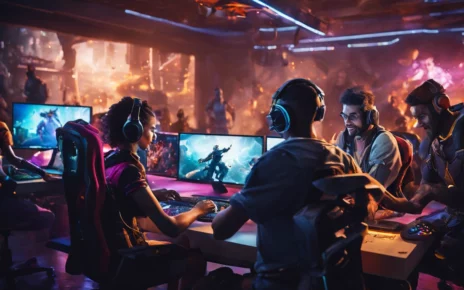The ‘Let’s Play’ phenomenon didn’t arise overnight. It’s the result of years of shared gaming experiences—friends huddled around consoles, swapping tips, laughing over failures, and marveling at hidden game secrets. These intimate, communal moments evolved into something much larger: a global movement that transformed how we experience and share video games.
What began as niche text-based storytelling on forums has grown into a cultural phenomenon fueled by platforms like YouTube and Twitch. ‘Let’s Play’ content represents more than just gameplay—it’s a celebration of creativity, community, and the evolving relationship between gamers and the games they love.
In this blog, we’ll trace its origins, examine the role of technology, and look forward to where ‘Let’s Play’ might be headed.
From Forums to Video: The Humble Beginnings of ‘Let’s Play’
The roots of ‘Let’s Play’ can be found in early online communities like ACMLM’s Board and Something Awful, where gamers gathered to share their adventures. These spaces allowed enthusiasts to document their playthroughs using text posts and screenshots, creating a narrative that felt like a mix of storytelling and strategy guide.
These posts didn’t just describe gameplay—they captured the emotions, struggles, and triumphs of players. Readers could imagine themselves navigating the same levels, facing the same challenges, and discovering the same secrets. These threads often included humor, insights, and clever commentary, offering a glimpse into the creator’s personality.
However, there were limitations. Screenshots and text couldn’t fully convey the real-time excitement of gaming. The advent of video-sharing platforms and affordable recording tools would soon change everything.
The Rise of YouTube and Twitch: A Game-Changing Shift
When YouTube launched in 2005, it opened the door to a new way of sharing and consuming gaming content. For the first time, gamers could upload videos of their playthroughs, complete with live commentary, for anyone to watch. This evolution from static screenshots to dynamic video marked a turning point.
Viewers didn’t just read about gameplay anymore—they could see every jump, every mistake, and every surprise. This made ‘Let’s Play’ content far more engaging and accessible, bridging the gap between creator and audience.
Soon after, Twitch entered the scene, taking interactivity to the next level. By allowing live streaming, Twitch enabled viewers to interact with creators in real-time. Gamers could receive advice, answer questions, or take on challenges from their audience on the fly. This format wasn’t just entertaining—it felt personal and spontaneous.
Why ‘Let’s Play’ Resonates: The Magic of Connection
The success of ‘Let’s Play’ is rooted in its ability to forge connections. It’s not just about showcasing gameplay—it’s about building relationships between creators and their audiences.
- Relatability: Unlike highly polished professional content, ‘Let’s Play’ videos often showcase raw, unfiltered gameplay. Creators laugh at their mistakes, celebrate their wins, and share moments of frustration, making them relatable to viewers.
- Accessibility: Whether you’re a gaming veteran or a curious beginner, ‘Let’s Play’ content offers an entry point. Even non-gamers can enjoy the humor, stories, and personalities behind these videos.
- Storytelling: A great ‘Let’s Play’ isn’t just about gameplay—it’s about how creators narrate their experiences. Their commentary transforms a playthrough into a journey filled with humor, insight, and emotion.
Creators like PewDiePie, Markiplier, and Jacksepticeye have become household names because of their ability to connect with audiences on a personal level. Their charisma, humor, and authenticity have turned them into cultural icons, proving that ‘Let’s Play’ is more than just entertainment—it’s a medium for storytelling and community building.
The Role of Technology: Making ‘Let’s Play’ Accessible to Everyone
The rise of ‘Let’s Play’ content wouldn’t have been possible without significant technological advancements. From affordable recording equipment to powerful editing software, technology has democratized content creation, allowing anyone with a passion for gaming to join the movement.
- Recording Tools: Early ‘Let’s Play’ creators had to rely on complex setups to capture gameplay. Today, tools like OBS Studio and Streamlabs make it easy to record or stream high-quality videos with minimal technical expertise.
- Editing Software: Platforms like Adobe Premiere Pro, Final Cut Pro, and even free tools like DaVinci Resolve allow creators to add polished touches to their videos, including overlays, commentary, and special effects.
- Affordable Gear: High-quality microphones, webcams, and capture cards have become more affordable, lowering the barrier to entry for aspiring creators.
- Social Media Amplification: Platforms like Twitter, TikTok, and Instagram help creators expand their reach, attracting diverse audiences and driving engagement.
These advancements have opened the door for more voices, perspectives, and creativity in the ‘Let’s Play’ space. Today’s creators represent a broader spectrum of gamers, reflecting the diversity of the gaming community itself.
Community Building: The Heart of ‘Let’s Play’
‘Let’s Play’ isn’t just about games—it’s about people. Communities naturally form around creators, bringing together fans who share a passion for gaming and a love for the personalities behind the videos.
- Interactive Dialogues: Platforms like Twitch foster real-time communication between creators and fans, making viewers feel like active participants.
- Shared Culture: Inside jokes, unique memes, and fan art create a sense of belonging within these communities.
- Inclusion: With creators from diverse backgrounds, ‘Let’s Play’ content reflects the broad spectrum of gamers, encouraging inclusivity and representation.
This collaborative spirit extends beyond the videos themselves. Fans often contribute to content ideas, participate in charity streams, and even organize meetups, strengthening the bonds within the community.
The Future of ‘Let’s Play’: VR, the Metaverse, and Beyond
The future of ‘Let’s Play’ lies at the intersection of emerging technologies and evolving audience expectations. Virtual reality (VR) and the Metaverse promise to revolutionize the way gaming content is created and consumed.
- VR Integration: Imagine a ‘Let’s Play’ experience where viewers can step into the game world alongside the creator. VR technology could transform passive watching into active participation, offering unparalleled immersion.
- The Metaverse: A shared digital universe could allow creators and fans to explore games together in real-time, redefining multiplayer experiences and fostering deeper community connections.
- AI and Personalization: Artificial intelligence could enable more tailored content, adapting playthroughs to individual viewer preferences.
However, these advancements also pose challenges. Accessibility, affordability, and inclusivity must remain priorities to ensure that all gamers can participate in the future of “Let’s Play.”
Conclusion: Why ‘Let’s Play’ Matters
The ‘Let’s Play’ phenomenon has redefined gaming culture, turning solitary experiences into shared adventures. From its humble beginnings in text-based forums to its potential future in VR and the Metaverse, ‘Let’s Play’ is a testament to the power of community, creativity, and connection.
As technology continues to evolve, so too will the ways we share and experience games. What remains constant is the heart of ‘Let’s Play’: a celebration of the joy, humor, and camaraderie that gaming brings to people worldwide.
So grab your controller, hit record, and join the movement—because the future of gaming culture is still being written, one playthrough at a time.




